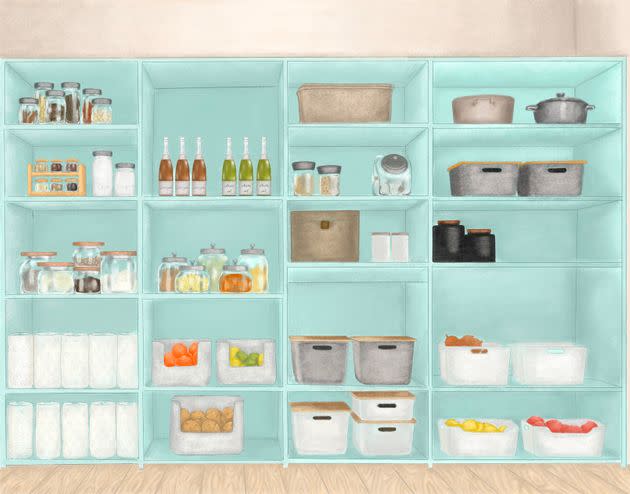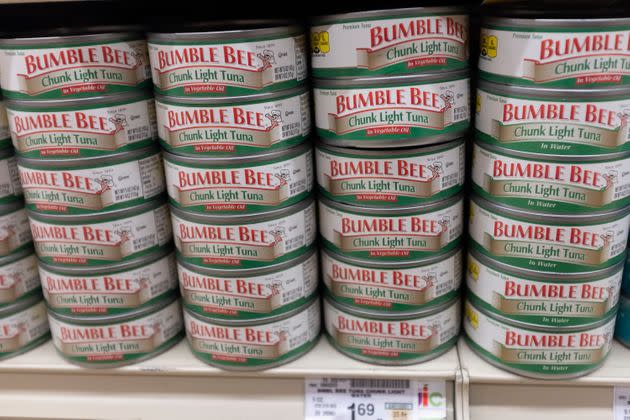How To Stock Your Pantry For A Big Emergency, From Hurricanes To Power Outages

(Photo: CreativeDesignArt via Getty Images)
My welcome-to-Miami party was a hurricane party. In 1992, newly married, I moved to South Beach just in time to be clobbered by Hurricane Andrew. Back then, we didn’t have a lot of warning either. On Saturday, we spent the day at the beach, and on Sunday we were shipping out under mandatory evacuation orders. The Category 5 hurricane struck early Monday morning, on Aug. 24.
Since then, my family and I have been through many tropical systems, ranging from Katrina to Irma.
Floridians like to kid around that we’re not afraid of hurricanes; we’re afraid of living without air-conditioning. But joking aside, what all of these real and potential natural disasters have taught me is how to truly prepare foodwise for a climate emergency. The truth is, as we’ve seen with Ian, these storms are not only life-threatening, but they’re also so destructive that it can take weeks to months — even years — to restore infrastructure.
How much food to stock in your pantry for emergencies
When threatened with a climate emergency, the Red Cross advises that you make a survival kit that includes “non-perishable, easy-to-prepare items,” enough for each family member, for three days. That’s if you’re planning to evacuate. If you’re sheltering in place, you should have two weeks’ worth. However, the Florida Division of Emergency Management doesn’t distinguish between staying or going, and recommends “at least” a seven-day supply of nonperishable canned or packaged fare.
For liquids, the general rule is one gallon of water per person per day, with the same guidelines as above. This isn’t only for drinking but also for brushing teeth and washing. Toilets also need to be flushed. Most Floridians (and residents of other storm states) are familiar with the concept of filling up all the bathtubs in the house before a storm hits in order to have extra toilet-tank water. But eventually, you will run dry if the plumbing lines are destroyed.
Stock up on appliances that can function during the storm
When we came back, we convinced everyone on our block to mutually invest in a gas line so we could cook and comply with boil-water advisories during future storms. When we moved homes in 2019, I elicited many eye rolls, but I would only look at kitchens that had gas stoves (or the option for installing one). Tout induction to me all you want, but there’s no way, given the option, I would knowingly rely on electricity in South Florida.
However, if you can’t get a gas stove in a hurricane zone, you should keep a propane-fueled grill on hand. While other types of grills are wonderful for smoking and barbecuing, trust me, you’re not going to want to light charcoal, pellets or wood chips every time you want to make mac and cheese for your kids’ lunch. (Remember, your microwave will likely be out of commission.)
We also keep at least two large, heavy-duty coolers on hand to store perishables. The best wildlife-proofed Yeti, RTIC, Igloo and the like are made to hold 40-degree temperatures for up to a week. Even better, some of these are fashioned for holding dry ice, which allows food to remain colder for longer. Once the electricity goes out, transfer the contents of your freezer and refrigerator to these coolers. Those latches prevent easy opening and closing, so you can control your family’s standing-and-grazing habits.
Of course, fighting for ice ahead of a storm is always a challenge worthy of a pro wrestler. But you can use your frozen goods in place of ice. It’s also an excellent practice to freeze ice packs, which are actually colder than ice, during hurricane season to avoid that last-minute rush.
Stock up on proteins and pastas
When setting up our pantry at the start of the season, we head to Costco and invest in packs of easy-to-open cans, large-format bags of rice and pasta, several different natural nut butters and flavors of jams and jellies, and boxes of crackers. These items are among the first things to sell out at Publix at the mere hint of a hurricane heading our way. That last lone jar of sugary, preservative-filled peanut butter in a long row of empty shelves is always a viral image.
But we don’t sacrifice our nutrition or quality preferences here. For example, Costco carries an eight-count pack of Kirkland canned organic diced tomatoes, a 12-count pack of Kirkland canned organic tomato paste, an eight-count pack of S&W canned organic black beans, 12-packs of boxed Annie’s organic macaroni and cheese and a six-count assortment of Garofalo organic pasta.
The same goes for tuna, another hurricane staple, and other canned proteins. Again, we’re able to maintain our sustainability ideals and health goals with Wild Planet and SafeCatch albacore and yellowfin tuna. These brands line- or troll-catch smaller migratory fish, low in mercury and high in omega-3. Both sound like they’d be pricy, but in bulk they’re reasonable, either from Costco or directly from their websites, which offer more variety.

With such a long shelf life, you really can't stock up on too much tuna. (Photo: NurPhoto via Getty Images)
Worried about waste if you buy too much tuna, salmon or sardines? Don’t be. “Most of Wild Planet products have a three-year best-by date printed on the package. However, the FDA has approved canned seafood to be good up to five years after production,” a Wild Planet rep said.
In addition, these and similar brands now offer single-serve pouches, which are less bulky to store and a blessing when you don’t have refrigeration.
Buy single-serving packages of food
In fact, single-serve anything is key (and the waste from using them is hardly your top concern when faced with a disaster like Ian). You simply don’t want to open a jar of anything that requires refrigeration. During the year, I collect condiments from take-out bags — cue another long-suffering look from my kids — and buy individual pods of creamer. Costco is also great for vending machine-size bags of nuts, dried fruit, jerky and other snacks. Products in larger bags will go rancid or soggy when opened and not finished in this kind of heat and humidity.
I also have a range of vacuum-sealed 8-ounce cartons of milks, dairy or plant-based, helpful for mac and cheese, soups, pasta sauces and the easiest hurricane meal of all, cereal.
By now, you’re probably thinking, Where does she store all this stuff? And you’re right. At some point, you run out of room. When it comes to drinks, it’s more compact to have powders that you can mix into water, which we get delivered once a month in five-gallon jugs. Those jugs stay in the garage or even outside on the backyard porch. We don’t return all of our empties, either. That way, when a storm does form, we can fill them with a hose and keep for toilet-flushing purposes.
Get organized ahead of time
Naturally, you must go lo-fi — or plan to — when it comes to hurricane food storage, prep and cooking. But beforehand is another story.
“Use a notebook application to record and make a list of food items that you need to service your entire family for a period and store it on your phone,” advised Walter Contreras, an expert in marketing technology and computer science IT. “Ideally, it should be an application that allows you to access the info in the case that there is no internet connection. Spreadsheets, Microsoft OneNote and Google Keep can be used offline. Google Keep Notes is also a great app that we individuals and families can use for saving recipes, shopping lists, and food supply information prior to the hurricane.”
If you want to get really serious about planning, Contreras recommends using a spreadsheet to determine your family members’ caloric needs.
“Prepare a list of all family members with their weight, height and BMI,” he suggested. “Enter the details into your spreadsheet to help calculate the amount of food and drink that you would need for a specific duration of time to feed the whole family. Once the spreadsheet is complete, print the spreadsheet and store in a place where it is easily accessible to all family members.”
If planning your own shopping is a task that confounds when you’re simultaneously preparing for evacuation, visit the Homeland Security website. There, you’ll find a ready-made list of emergency food supplies that you can download and save to your mobile device.
Finally, most cans have pop tops now. But some don’t. So don’t forget the most important item of all in your prep: a can opener, which usually has that other all-important tool on it as well — a bottle opener. Pro tip #335: Drink your beer while it’s still cold.
This article originally appeared on HuffPost and has been updated.
